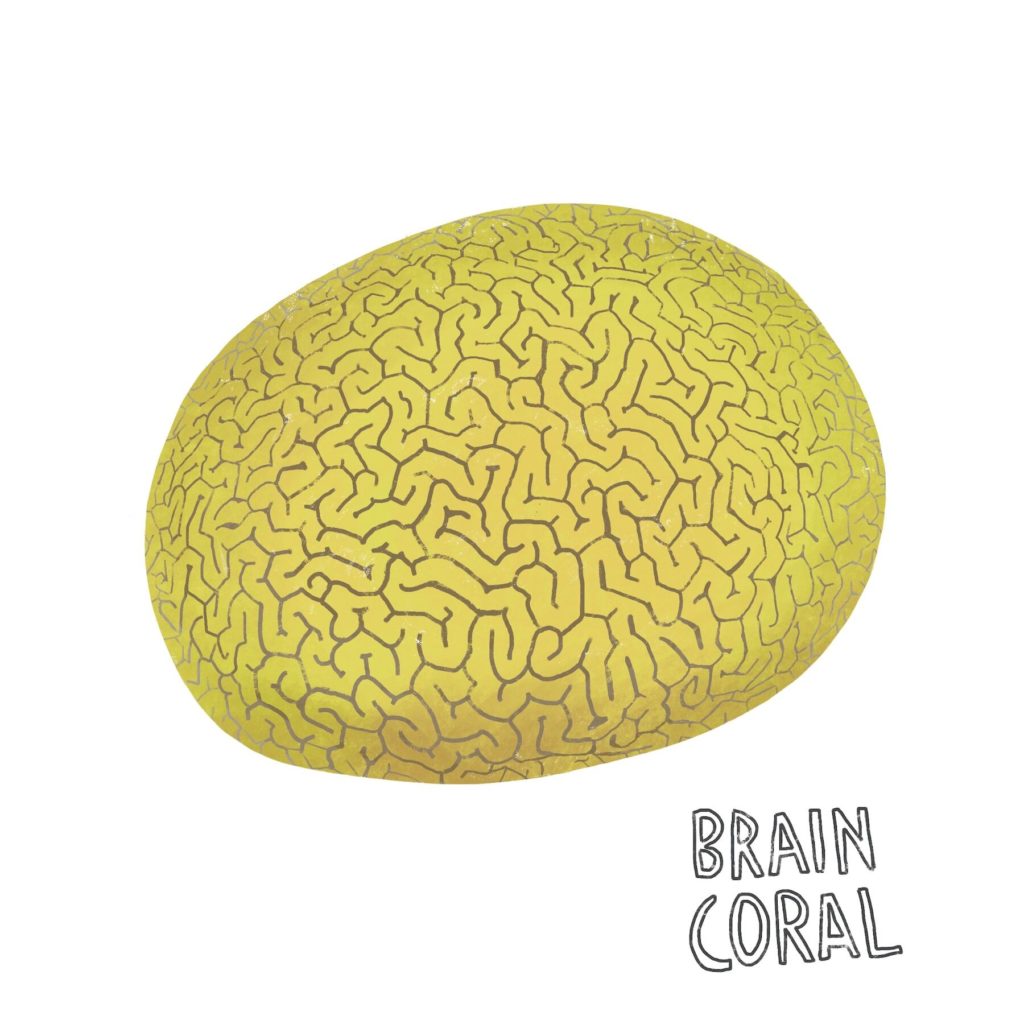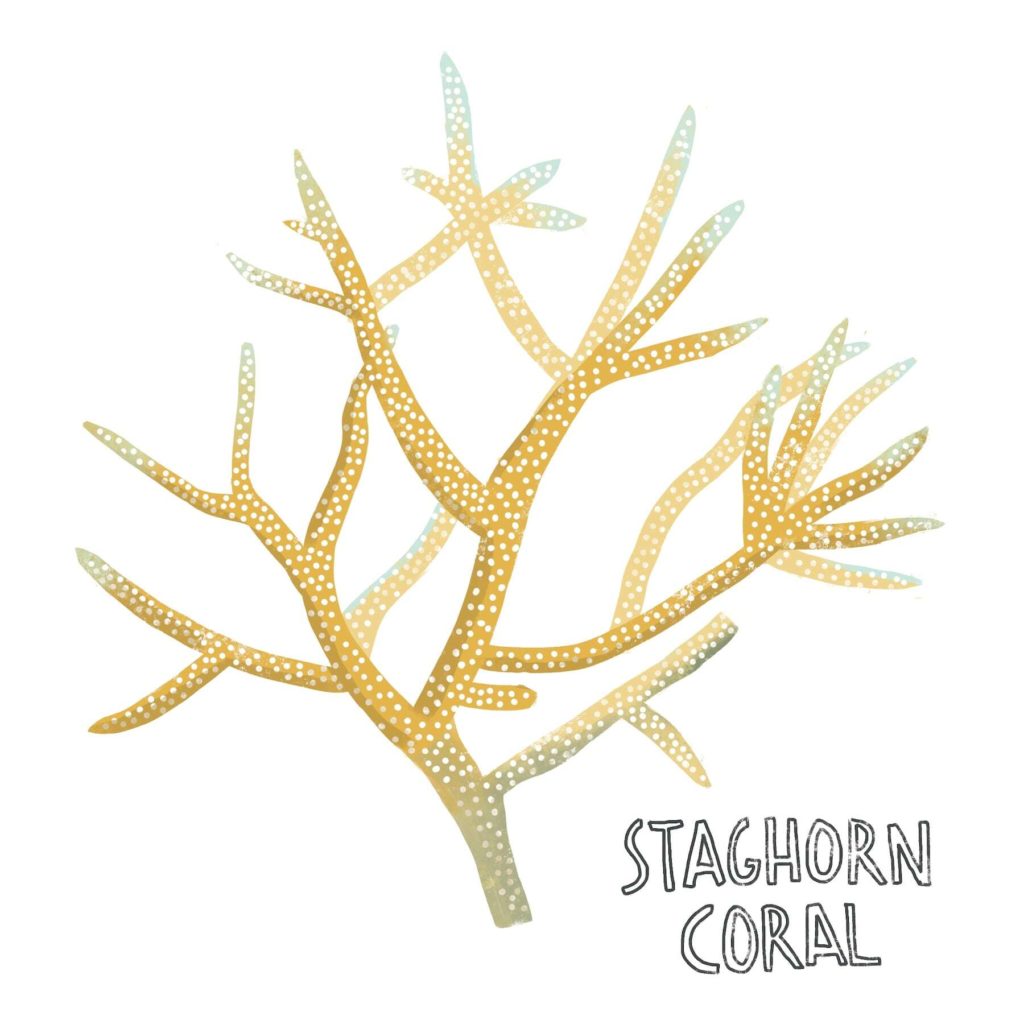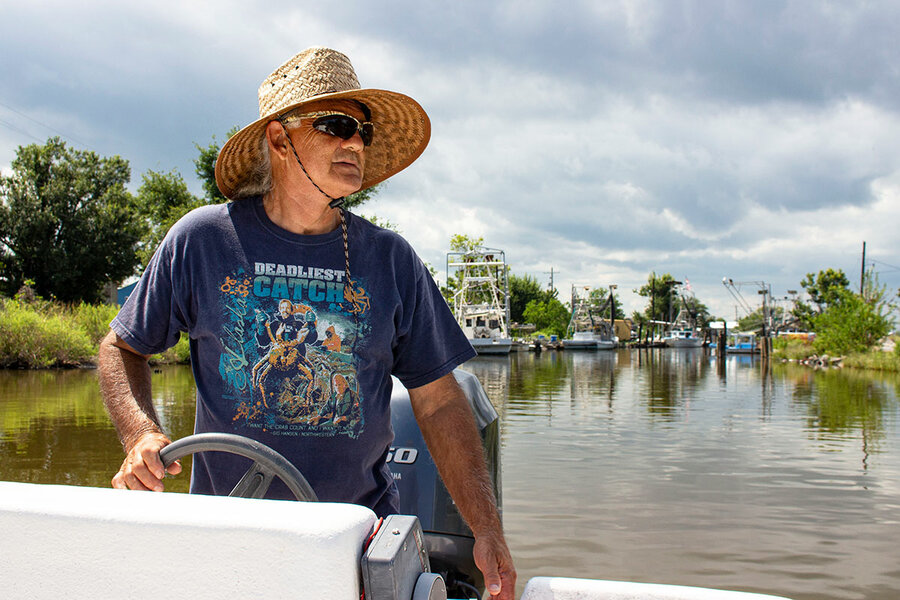Original publication by Allyson Chiu, illustration by Stef Wong for washingtonpost.com on 29 September 2022
Coral Vita, a for-profit company, aims to grow corals up to 50 times faster than in nature, improve their resilience to climate change and provide large-scale restoration services through land-based farms
GRAND BAHAMA, Bahamas — Sam Teicher hovers over a section of Rainbow Reef, his yellow and black scuba fins stilling in the turquoise waters of the Atlantic Ocean. Contrary to the reef’s colorful name, the corals below him make up a bleak palette of grays. He looks up from the broken, stick-like pieces and uses one hand to make a slicing motion across his throat. Dead.
Leaving the coral graveyard behind, Teicher swims to another area of the reef nearby, carefully steering clear of healthy elkhorn corals that dot the seascape.
Tiny, yellow fish dart away as he moves closer to a cluster of finger-sizedstaghorn corals — a critically endangered species essential for reef-building — protruding from a plate attached to the reef. Teicher gestures toward the lemon-hued branches, then points at himself. Ours.
The small collection of corals is one of many that were farmed on land and then planted onto reefs near Grand Bahama island this year by Coral Vita, a company founded by Teicher and fellow Yale University graduate Gator Halpern that is trying to help drive restoration of coral reefs — vital ecosystems that are being decimated around the world by climate change.
Efforts to revive coral reefs have existed for decades. Traditionally, restoration has involved growing corals in the ocean, with natural growth rates per year ranging from less than a centimeter to up to 10 centimeters, depending on the species. But as the threat against reefs has intensified, researchers are introducing innovative methods to farm, grow and plant healthy corals more efficiently.
These advances include growing them in tanks on land, or using advanced techniques to boost growth rates and resiliency to the changing environment. Coral Vita’s founders say they are integrating a range of these approaches — such as cutting corals into small pieces, a process known as “microfragmentation” — to grow corals up to 50 times faster than in nature, improve their resilience to climate change and provide large-scale restoration services through land-based farms.
The idea behind a farm model that combines science and production technology is to “reframe the process of coral farming from kind of a coral-gardening style that it traditionally has been and move it more towards a coral-factory-style setup,” says Halpern, 32, the company’s president.
In another twist, Coral Vita is operating as a for-profit company — an approach to funding that has drawn some skepticism within a field dominated by nonprofit organizations and research institutions that are typically funded by grants and philanthropic donations. But Teicher and Halpern say their for-profit model, which can generate revenue from various sources including restoration contracts and ecotourism, is necessary to repair reefs on a massive scale.
Traditional coral farming has “a very important role to play,” Halpern says.
But Teicher, 32, the company’s “chief reef officer,” says a for-profit model may unlock sources of funding that could help make the field less dependent on grants and donations at a time when climate change and human activity, such as overfishing and pollution, are rapidly degrading coral reefs.
While reefs occupy less than 1 percent of the ocean floor, but are home to more than 25 percent of marine life. They also provide a host of essential resources to people, such as food, coastal protection, and income from tourism and fisheries.
Coral can be particularly vulnerable to rising ocean temperatures. If the water is too warm, corals will expel the algae that live in their tissues. These algae not only give corals their vibrant colors, but also serve as a source of nutrients. Without their plant partners, corals turn white, a process known as coral bleaching, and can die over time.
Mass die-offs of coral reefs, which are also affected by disease and ocean acidification,would have far-reaching ecological, economic and security consequences, scientists say. Their demise could deplete biodiversity, eliminate a major source of food and income for people, and leave coastal areas even more vulnerable to powerful waves and extreme weather.
Since launching its pilot farm in Freeport on the island of Grand Bahama in 2019, months before a powerful hurricane devastated the island, Coral Vita has attracted global attention.The company was recognized last year as one of five inaugural Earthshot Prize winners, an environmental award established by Britain’s Prince William that gives awardees a million pounds (about $1.07 million in today’s dollar) each to fund their work.
“There are 100 countries and territories, more or less, with coral reefs,” Teicher says. “There need to be large-scale coral farms in every single one of them.”
Coral Vita — which has raised more than $4 million in funding from a roster of investors including Sustainable Ocean Alliance, Apollo Projects and Builders Initiative — planted their corals for the first time earlier this year. The company has grown its team to more than a dozen people, with plans to expand further. But Teicher says that it matters less whether Coral Vita is involved in these other farms, as long as “the impact is happening.”
“Coral restoration is not a silver bullet. We need to stop killing coral reefs,” he says.
But with scientists warning that climate change could largely wipe out the world’s coral reefs by 2050 without a major cut in greenhouse gas emissions, Teicher says the Coral Vita team is focused on another target: for there to be a “thriving restoration economy where reefs and communities are prosperous and healthy and surviving because we’re investing and taking care of them.”
“Hopefully, we can have a transformative model,” he says. “You can do for-profit for good.”

Scalable ‘smart’ farms
Signs at the intersections of weathered roads direct visitors to the Coral Vita farm, a collection of utilitarian structures sitting on about two-and-a-half acres of land that run along part of Grand Bahama’s extensive seawater canal system. Neat rows of turquoise and white tanks sit under nets of black shade cloth stretched over an open-air structure made of wooden beams. A chocolate brown, two-story building nearby houses the farm’s laboratory and indoor workspaces.
“It really is one of the most state-of-the-art facilities for coral restoration,” says Teicher, who strolls around the farm in a company T-shirt, navy board shorts and worn, brown flip-flops.
Typically, pieces of coral are grown in underwater nurseries before being planted on reefs — a common process that is low cost, doesn’t require complex technology and keeps the corals in their natural environment.Coral pieces are typically hung like ornaments from treelike structures made of PVC pipes before being transplanted back onto reefs or used as stock to grow more corals. But these corals are often vulnerable to the elements, as well as disease and predation, says Jessica Ward, the U.S. Virgin Islands coral manager at the Nature Conservancy.
Land-based nurseries — such as the Coral Vita farm, where corals are nurtured in tanks before being planted onto reefs — are becoming more common.
While the operations tend to come with a hefty price tag and are more labor intensive, they provide an opportunity to raise corals in a controlled environment where experimental methods could be used and “allows for scalability of restoration,” Ward says.
“Restoring reefs at scale means we can restore large areas of reef in a shorter amount of time than more traditional methods, and more efficiently, with the goal of getting reefs to a point where they are self-sustaining faster,” she says. “This is crucial to saving coral reefs in the face of myriad threats that are not abating, particularly climate change.”
The bits of coral growing in the tanks at Coral Vita’s farm are the product ofmicrofragmentation, where cutting larger chunks of coral into small pieces stimulates growth in the same way human skin heals from a wound. Marine biologist David E. Vaughan, who is credited with discovering the method, says it is “a game changer for corals.”
In just a couple of years, microfragments cut from the same coral that are planted onto reefs can eventually fuse together to become a head of coral, a process that would take anywhere from 25 to 100 years to happen naturally, says Vaughan, who consulted for Coral Vita during its earlier years but no longer has financial ties to the operation.
What’s more, he says, even though these corals are “only kindergartners,” their size triggers them to act like mature corals and become reproductive during spawning season.
Coral Vita is also beginning to experiment with “assisted evolution,” or techniques aimed at accelerating adaptive processes that happen in nature. For corals, these methods largely focus on improving resilience to climate change, such as increasing heat tolerance, says Madeleine van Oppen, one of the researchers who published a foundational scientific paper on assisted evolution in 2015.
There is “no genetic modification, but it’s just speeding up what happens naturally,” says van Oppen, a professor at the University of Melbourne and the Australian Institute of Marine Science.
One approach, for instance, involves breeding the most heat-tolerant corals found on the reef to produce heat-tolerant offspring for restoration. These corals can be identified by exposing corals to environmental conditions that reflect a warming planet and observing how the specimens react.
Some worry that assisted evolution techniques”would create a super coral that will outcompete anything that is still there,” van Oppen says. “I personally think that’s quite unlikely. The improvements that we see are relevant, but not such that I think that they will just wipe out anything.”
Additionally, the farm is outfitted with a high-tech aquaculture system, referred to by Coral Vita employees as the “life support system,” which supplies water to the tanks and can regulate water quality through temperature, pH and other adjustable settings.
The land-based system can be replicated elsewhere, Teicher says, with some adjustments for a region’s specific coral. “It can be very plug and play, which is really important for being scalable.” he says.

Selling restoration
The potential for scalability is critical to Coral Vita’s business plan, which is connected to the idea of “selling restoration as a service,” Teicher says.
While Teicher says that grants and awards have made up a “larger chunk” of the company’s revenue streams, Coral Vita signed its first restoration contracts with the Bahamian government and the Grand Bahama Port Authority in 2021.Though the payment amounts are “not that large,” he says that “for any island nation government to commit funds to something like coral reef restoration is amazing.”
The company has also been able to generate revenue through other sources. For instance, paying visitors can take an educational tour of the farm. Coral Vita also has an adopt-a-coral program, through which individuals and corporations can sponsor anything from small fragments to entire tanks. Last year, Teicher says, the coral adoption program brought in more than $60,000.
The work “speaks to their commitment to Grand Bahama, speaks to their commitment to the Bahamas, and it speaks to their commitment to sea life,” says Clay Sweeting, the minister of agriculture and marine resources in the Bahamas. “It’s a big task to undertake.”
The business, Teicher and Halpern say, has weathered its share of challenges.
“It’s been a long and rocky road to get here,” said Halpern, speaking over Zoom from Saudi Arabia.
“We’re not a for-profit because we get to make money and become rich,” he adds. “The amount of funding available in the philanthropic nonprofit space is a drop in the bucket in terms of the opportunity that exists to be able to make a difference if you’re able to harness the power of capitalism for the benefit of the environment.”
But the company’s for-profit model has prompted some skepticism.
“All the other groups that are working on these problems are doing it for the good of the planet and not to make a profit,” says Gail Woon, a marine biologist and founder of Earthcare, a nonprofit environmental education organization based in Grand Bahama. “I’ve always had a problem with that part of their project.”
It also remains to be seen if a for-profit approach such as Coral Vita’s can have its intended large-scale impact on the reef, says Vaughan, who now heads the nonprofit Plant A Million Corals Foundation, which he founded.
A farm operation that may have, at minimum, about a couple million dollars in start-up costs and plants fewer than 5,000 to 10,000 corals a year “isn’t the economic scale that we need to get this to,” Vaughan says, adding that hundreds of thousands of operations “costing couple of dollars a coral” will be required.
“This is a different philosophy and a different model, and if that is what gets corals planted to save our reefs, save our ocean and save our planet, great,” Vaughan adds. “We’re going to go and stick with the nonprofit model and try to get there faster with the ability to get to scale.”
Still, Woon says, she believes Coral Vita’s work holds promise. “It is scalable, and it is doable,” she says. “I want to see them be successful.”

Rocky beginnings
It all started in 2013 with a conversation between two friends in their first year of graduate school at what is now known as the Yale School of the Environment. They were hanging out on the back porch of a clapboard house on a tree-lined residential street in New Haven.
Despite being a scuba diver, Halpern, a San Diego native, had never heard about the possibility of restoring degraded reefs. Meanwhile, Teicher, who grew up in D.C. and also dives, had worked on a coral restoration project that used the traditional method of growing corals in underwater nurseries.
As Teicher recounted this experience to Halpern, the two realized they could try to take a different approach.
Armed with their idea and some funding from grants, the pair enlisted the help of coral experts such as Vaughan. Coral Vita landed its first investor in 2016 and others soon followed, including former Washington Nationals pitcher Max Scherzer, who now plays for the New York Mets, and his wife Erica.
Teicher and Halpern chose Grand Bahama as the site for the company’s first farm after evaluating factors such as water quality at restoration sites as well as potential for ecotourism and local and government partnerships. They moved to the seahorse-shaped island in 2018.
By May of the following year, the farm was open and operational, growing 24 native species of coral. (Most restoration projects in the Caribbean grow between two to five species, Teicher says.)
They experienced a coral spawning event, a natural phenomenon where corals in the ocean reproduce by releasing their eggs and sperm at the same time. School groups were touring the farm. Restoration inquiries were coming in.
Then, on Sept. 1, 2019, Hurricane Dorian slammed into Grand Bahama, generating a 17-foot storm surge that left much of the farm underwater. Despite their best efforts to secure everything, the company’s tanks were washed away and none of the corals survived — a year and a half’s worth of work lost.
“It just was destruction,” Teicher recalls.
Elsewhere on Grand Bahama, though, the devastation was much worse. Entire homes were gone. Dozens of people were dead, and even more were missing, numbers that are probably underestimates of the storm’s true toll. Emergency responders couldn’t reach parts of the island where roads were blocked by water and storm debris or that had been completely washed out.
Coral farming was no longer an immediate priority. “We’ll just go help people,” Teicher says, remembering the decision to pivot to assisting with relief efforts. “There’s nothing else to do but help people at this point. That’s what we could do.”

Teicher says he and other Coral Vita employees were among the first people to reach some of the island’s eastern settlements, including High Rock, which was one of the communities hit hardest by Dorian.
“Coral Vita turned into Rescue Vita,” says Alannah Vellacott, a marine ecologist and Grand Bahama native who was Coral Vita’s first Bahamian employee.
“I’m really, really grateful that they wanted to be those people for the Grand Bahamians that lived in the Eastern communities,” says Vellacott, 32, whose childhood home was destroyed during Dorian.
As the community of Grand Bahama began the process of recovering from Dorian, so did Coral Vita. The company recovered all but one of its coral tanks and began rebuilding in November 2019.
“I thought they would come in, see that it’s not worth it, or come in, run out of money,” Vellacott says. But “they stayed after Dorian,” she adds, eyes glossing over, voice thick. “It was then that I realized that they were actually going to stick around.”

A broad impact
Since reopening the farm in March 2020 and surviving the pandemic, “basically everything is finally where we want to be,” Teicher says on one sweltering August morning as he walks along a path by the coral tanks.
From February to July this year, Coral Vita completed its first out-planting session, planting roughly 5,600 corals grown at the farm across two areas of reef. While some permitting issues and inclement weather impacted their ability to hit their goal of planting 10,000 corals by the summer, Teicher says, the team hopes to have that many corals, and ideally more, planted by the end of the year.
But the company intends for its impact to go beyond the environment, its founders say.
Coral Vita works with other local environmental organizations, and more than half of its growing staff is Bahamian, according to Teicher.
“I don’t want to give my child an ocean that they cannot be fed by, be comforted by, that they can’t play in and have a great time,” says Vellacott, who grew up exploring mangroves in the backyard of her childhood home and the expansive ocean that surrounds the island. A gold conch pendant — “a reminder of who I am and where I came from” — and a signet ring that belonged to her father, a biology teacher, hang from a gold chain around her neck.
Vellacott looks out from the second story of the farm’s main building, motioning in the direction of the rows of tanks. “This is all going to be for my children, for my nieces and nephews, for future Bahamians, for this region,” she says.
“We’re not going to see restored reefs in our lifetime,” she adds. “None of this is for us. It’s for the future.”





